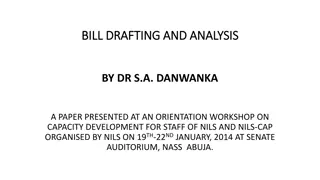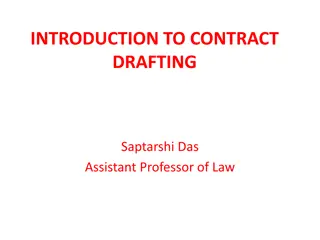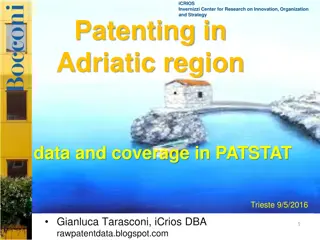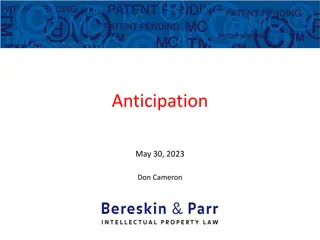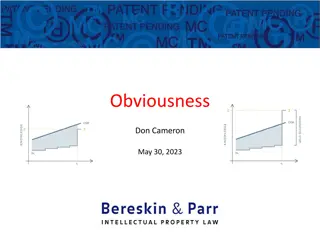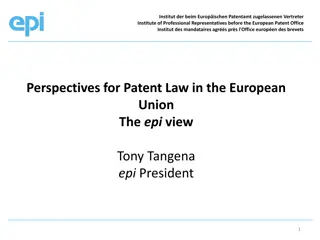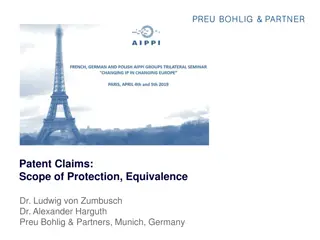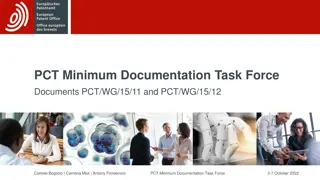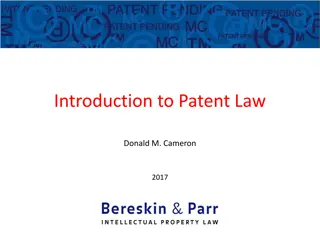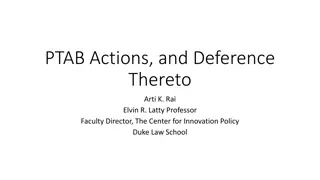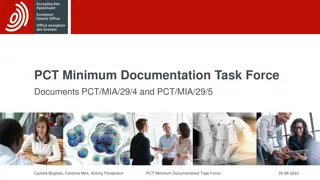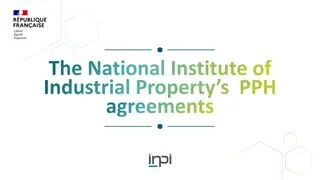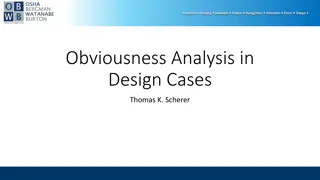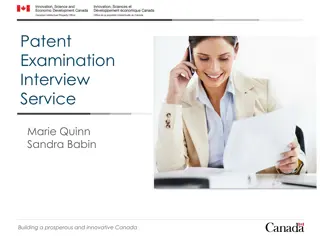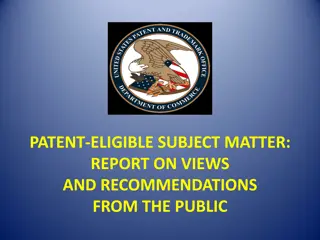Understanding Patent Claim Drafting Essentials
Learn key concepts of patent claim drafting, including the roles of the inventor, patent agent, examiner, and other involved parties. Discover the importance of crafting clear and precise claims to protect inventions effectively, with examples illustrating narrow and broader claim scopes.
Download Presentation

Please find below an Image/Link to download the presentation.
The content on the website is provided AS IS for your information and personal use only. It may not be sold, licensed, or shared on other websites without obtaining consent from the author. Download presentation by click this link. If you encounter any issues during the download, it is possible that the publisher has removed the file from their server.
E N D
Presentation Transcript
DRAFTING KLAIM PATEN Belajar dari: WIPO PATENT DRAFTING MANUAL Mohammad Mohammad Isrok Sentra KI - Universitas Muhammadiyah Malang Isrok, SH., CN., MH , SH., CN., MH Konsultan HKI No. 622-2012 m.isrok@gmail.com 0812 3399 1006
Catatan pengantar: Inventor orang yang menemukan invensi (penemuan) Patent Agent orang yang membantu membuat drafting spesifikasi paten. Paten agent bisa seorang lawyer (disebut patent lawyer atau attorney) dapat juga seorang enggineer (disebut juga Patent Enggineer) Examiner pemeriksa paten pada kantor paten negara yang menentukan kelayakan untuk diberi paten Patent Holder Pemegang paten, bisa inventor maupun orang lain yang mendapatkan dari inventor Infringer Pihak yang melanggar paten
teori klaim paten
Suatu klaim membuat tanda batas dari perlindungan yang diberikan oleh Paten Suatu klaim menentukan luasan (scope) proteksi yang diberikan oleh paten Suatu klaim memberikan batas terluar dari suatu proteksi paten Suatu klaim memberitahukan dengan jelas dan tegas tentang apa yang diklaim oleh pemohon untuk menjadi invensi miliknya.
KLAIM PUBLIC DOMAIN KLAIM Invensi A Invensi B PUBLIC DOMAIN PUBLIC DOMAIN Invensi C
Suatu invensi adalah suatu konstruksi mental dalam pikiran inventor yang belum punya bentuk fisik. Suatu perwujudan dari invensi adalah bentuk fisik dari invensi di alam nyata. Suatu klaim harus melindungi setidaknya satu perwujudan dari invensi Namun klaim paten yang paling baik adalah yang memberikan perlindungan sedemikian rupa sehingga tidak ada perwujudan lain dari invensi yang bersangkutan yang dapat dibuat, digunakan atau dijual oleh orang lain tanpa adanya pelanggaran terhadap klaimyang bersangkutan
Contoh Assume that an inventor invents the first cup to have a handle He makes a physical embodiment of his invention in the form of a red clay cup with a handle narrow claim : the red clay cup with a handle Broader claim: the cup with a handle
contoh Asumsikan bahwa seorang inventor menemukan (invent) untuk pertama kalinya suatu cangkir yang memiliki pegangan Dia membuat perwujudan fisik dari invensinya tersebut dalam bentuk cangkir keramik merah dengan suatu pegangan. Klaim sempit: suatu cangkir merah dengan satu pegangan Klaim luas: suatu cangkir dengan pegangan
Peran Inventor: Menemukan (invent) sesuatu (produk atau proses) Peran Konsultan Paten: Memastikan bahwa klaim paten telah mendekati ruang lingkup maksimalnya. Peran Pemeriksa Paten: Mencegah suatu klaim paten agar tidak keluar dari ruang lingkup (scope) invensinya (Teori maksimum)
Hubungan antara Specification claim The specification must support the claim Every single claim has adequate support in the specification The choice of words and terminology used in claims should be traced back to the specification to ensure that the specification and claims are consistent and that the same terminology is used throughout.
The Application Must Contain: One Or More Claims . These Claims must: i. define the matter for which protection is sight ii. be clear and concise iii. be supported by the description
Since the extent of the protection conferred by a patent is determined by the terms recited in the claims clarity of the claims is of the utmost importance The claims interpreted with the help of the description and the drawings
The EPO recommends that claims be drafted in terms of the technical features of the invention The claims should not contain statement relating, non-technical matters.
B. F O R M A T CLAIM PATENT
A patent claim has three parts: The preamble: The transitional phrase The body The preamble The transitional phrase The body
Example 1. A Patent Applicant has invented a rice cooker An apparatus for cooking rice An apparatus for cooking grains An apparatus for cooking
Example 2: A Patent applicant wants to claim a unique method of making tea. A method for making tea A method for making a plant-based beverage A method for making a warm beverage
Example 3: A Patent applicant has invented a compound to treat malaria A Composition for treating malaria A method for .. A device for ..
Transitional Phrase (open ended) An apparatus, comprising: a pencil; an eraser attached to one end of the pencil; and a light attached to the center of the pencil.
Transitional Phrase (Closed phrases) An apparatus, consisting of: a pencil; an eraser attached to one end of the pencil; and a light attached to the center of the pencil
The Body of Claim An apparatus for holding items, comprising: at least one leg; and a top configured to support at least one leg
The Body of Claim An apparatus for holding items, comprising: four legs; 16 screws; and a top
Two-Part Claims/ Improvement Claims/ Jepson claim
the preamble of the claim sets out the most relevant known prior art, and the body characterizes the improvement of the invention. The preamble and body are connected by a specific transitional phrase. Thus, the preamble is the statement of the prior art, the transition is a phrase such as characterized by, and the body provides the novelty
In Europe, for example, the preamble is followed by the transition characterized in that or characterized by. In the US the preamble is typically followed by the transition wherein the improvement comprises The preamble should typically reference only a single piece of prior art since the preamble is considered an implied admission that it is prior art.
Example: A pencil having an eraser, wherein the improvement comprises a light attached to the pencil. Thus, in this claim a pencil having an eraser is the relevant known prior art and the claimed improvement is the attached light.
The EPO recommends that the first part of such claims contain a statement indicating the designation of the subject matter of the invention, i.e. the general technical class of apparatus, process, etc. to which the invention relates followed by a statement of those technical features which are necessary for the definition of the claimed subject matter but which, in combination, are part of the prior art. This statement of prior art features applies only to independent claims and not to dependent claims. Thus, such statements are necessary only to refer to those prior art features which are relevant to the invention.
For example, if the invention relates to a photographic camera but the inventive step relates entirely to the shutter, it would be sufficient for the first part of the claim to read: A photographic camera including a focal plane shutter and there is no need to refer also to the other known features of a camera such as the lens and view-finder. The second part or characterizing portion should state the features that the invention adds to the prior art, i.e. the technical features for which, in combination with the features stated in the first part, protection is sought.
Means-Plus-Function Claims
Means-plus-function claims recite elements that do not have specifically-defined structures but instead recite functions performed by structures disclosed in the specification. The interpretation of means-plus-function claims varies from jurisdiction to jurisdiction and even varies within jurisdictions over time. For example, a given jurisdiction may interpret a means-plus-function claim as the means disclosed in the patent s specification for performing the recited function plus the reasonable equivalents of those means. Means-plus-function claims could receive either a broad or narrow interpretation in a given jurisdiction since the claims do not specifically define the structure. Litigants in patent infringement cases sometimes expend considerable energy arguing over whether or not an asserted claim even is a means-plus-function claim.
The format of a classic means-plus-function claim is the word means followed by a function. For instance, if the invention is a rice cooker, a claim in the means-plus-function format might read as follows: An apparatus for cooking rice, comprising: a means for holding rice; and a heater configured to heat the rice- holding means. In this example, notice that instead of reciting a rice- holding structure by name (e.g. a bowl), we have referenced a device that performs the function of holding rice. By doing so, we have avoided using a specific name and have instead recited the function that it performs.
Claim Punctuation
A comma typically separates the preamble from the transitional phrase and a colon typically separates the transition from the body. The body itself is typically broken into small paragraphs that define the logical elements of the claim. Many jurisdictions do not have specific laws requiring such punctuation but the patent agent should strive to make sure that the claim will be interpreted as he intends. Similarly, in many jurisdictions a claim element might not have a precise and/or legal meaning, with all the words of a claim simply being limitations to the claim. That said, the patent agent must write the claim in a manner that does not complicate claim interpretation by the patent examiner and later by courts and potential licensees. Thus, the elements of a claim are typically separated by semi-colons and the penultimate element ends with ; and.
Example 1. Preamble, transition: Element (#1); Element (#2); and Element (#3). Example 2. An apparatus, comprising: a plurality of printed pages; a binding configured to hold the printed pages together; and a cover attached to the binding.
Proper Antecedent Basis
The elements in a patent claim must have the correct antecedent basis. This means that the first time an element is introduced, the indefinite article a or an should be used. Later when referring back to previously introduced elements, the definite article the or said should be used. Proper antecedent basis is not just a good idea; like gravity, it is the law. The following set of claims will help explain proper antecedent basis:
1. 2. A device, comprising: a pencil; and a light attached to the pencil. The device recited in claim 1 wherein the light is detachably attached to the pencil. The device recited in claim 2 where in the pencil is red in color. 3.
Notice that in Claim 1, we introduced the pencil for the first time by referring to it as a pencil. In the same claim, we also introduced the light for the first time as a light. However, when we wanted to specify that the light was attached to the pencil, we referred to the pencil as the pencil. The use of the word the signaled that the pencil was the one we had previously defined in the claim. Otherwise, there would be ambiguity as to whether it was the same pencil or another pencil. The words the and said are interchangeable in claims drafting. ( Said is old-fashioned legalese for the most part, while the is an attempt to make language more accessible to non-lawyers.)
Reference Numerals and Bracketed Expressions
In some jurisdictions, claims are encouraged and/or required to recite the reference numerals associated with particular elements in the patent application s drawings. Thus, if Figure 1 of the patent shows a computer memory and this computer memory is labeled 123, for example, if the claims recite this particular computer memory, the computer memory element will be followed by the reference number 123.
An apparatus, comprising: A plurality of printed pages (11); A binding (14) configured to hold the printed pages (11) together; and A cover (21) attached to the binding (14). The numbers in parenthesis are the reference numbers from the patent application s drawings.
For example, a wherein clause is generally used to describe either a function, operation or result that flows from the previously-recited structure or function of the claim. Thus, wherein clauses should be used where the result necessarily follows the recited structure or function. For instance, if we want to claim a folder for keeping files, the claim in a wherein format might read as follows: A folder for keeping files, wherein the folder is configured to receive the files
Multiple Elements: Many patent offices require claims to recite at least two elements. A patent claim without many limitations can be impossibly broad. One can readily see the necessity for this rule by comparing the following two claims: Example 1. A computer, comprising: a processor. Example 2. A computer, comprising: a processor; a memory; and a bus configured to transmit data between thememory and the processor
TERIMAKASIH MOHAMMAD ISROK, SH., CN., MH Konsultan HKI RI No : 622-2012 Advokat Peradi, NIA :15-10269 Dosen Pengajar : HKI, di FH UMM HP : 081233991006 E-mail : m.isrok@gmail.com







